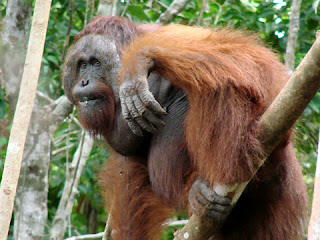Over the course of a few days while following animals at Sungai Lading in 2006, I jotted the following poems about some of my focal subjects down in my field notes (what can I say, living in the forest for lengthy periods of time without anyone to speak to in English can cause a person to write some pretty nutty things!):
RHOMA’S STORY
Rhoma has a big long beard
And watch out, he should be feared
He throws branches big and small
It helps not if you’re big or tall
Rhoma is lazy today
My assistants say hooray!
Only five more hours of this
Then back to camp for sleeping bliss
I should not write on my data
But better than on the peta
I do not want to go crazy
Which I will if I am lazy
He kiss-squeaks now and will more later
I think he’s a human hater
Rhoma is so light in color
Only paler is my mother
But he’s red and she is not
Unless the sun is very hot
Well, I guess that’s always true
But to rhyme that’s what you do
Today with me are two local men
I feel like a mother hen
Here assistants call me “Mother”
It’s a place like no other
Other times they call me “Boss”
Which is better? It’s a toss
At least here they don’t call me “Mister”
Or ask me if I have a sister
I was bit by two big ants
Through the leg of my field pants
Then I sat on a big worm
My assistants sure did squirm
The worm was green
The guts were too
They’ll stick onto you like glue
Only one more page to go
Before jam golek, that I know
Rhoma just awoke from sleep
Before no not a single peep
Standing way too close to me
Is a very big dead tree
I hope that wind does not come round
And knock the tree onto the ground
Rhoma shook that tree, you see
He even tried to flatten me
He just wanted to snag crash
And after have himself a bash
Because we’re here he eats so little
He thinks we get in the middle
Of his plans to procreate
But he should just habituate
Two leaf monkeys came to eat
In Rhoma’s tree, that sure was neat
May this poem give you pleasure
Read it now or at your leisure
This is Rhoma’s only story
Hope it brings him lots of glory
Rhoma should get his due fame
And if he doesn’t I’m to blame
Studied for my dissertation
He gave me a laceration
But I am not really mad
He is really not so bad
But why not start to make a nest
So we can all go home and rest
We’ll follow him into the night
For late to golek is his right
It is we who follow him
So we must accept his every whim
He made not one nest but made two
What is it that we are to do?
First we must wait to be sure
Which nest he’ll choose to endure
If we must we’ll wait all night
We cannot put up a fight
Then he’ll start another day
By 4 AM, he won’t delay
His name is Elvis
He sometimes long calls
But when he tries to be the star
Suni he is never far
Elvis can kiss-squeak
And throw epiphytes
But assistants they don’t run
For with Elvis all is fun
Across the flooded swamp
Elvis he sure can romp
He has missing teeth and a loud grumble
But branch missiles he does fumble
In the swamp, Sungai Lading swamp
The hottest spot north of Palangka
In the swamp
The deep peat swamp
Elvis’s yawning is always the fashion in the swamp…
Elvis is not dead
Lala she has real big hair
But when we search she’s not there
She looks so much like Elvis
Lala’s family
Lala, well she is crazy
Snag riding! She’s not lazy
If she would party with Gula
A “Gulala” we’d have
Velveeta is a cheese
She really likes to sneeze
When she enters thick rotan
You must have a good plan
Pregnant she may be
We have to wait and see
High ho the dairio
Velveeta is a cheese
Franklin knocked her up
Like me she does hiccup
High ho the dairio
Velveeta is a cheese
Suni is made for walking
And that’s just what he’ll do
One of these days that Suni
Will just walk all over you
Assistants they do scramble
Underneath the bramble
When Suni leaves the trees
We all get right down on our knees
One day he came to camp
Without even a headlamp
Suni is made for walking
And for causing lots of gawking
And this bizarre little poem, written by whoever manufactures Snowman brand markers in Indonesia, is too amazingly odd not to share:
 |
| a similar caption appears on this box of Snowman markers and reads: This talk, truth was some the sad thing, Is the love and the geological features it is...FLY TO THE SKY... |
SNOWMAN
6 Coloring Markers
Pencil Type
FLY TO THE SKY…
The tree
professional
everyday looks
the sky which
is the fairy
and it does
cluck cluck
and it cries
















































